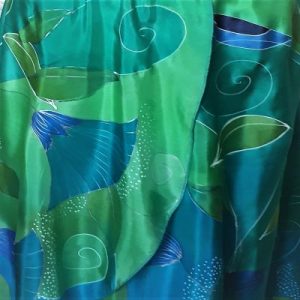If you’ve ever had the chance to touch real silk, you know what a magical feeling it is; the softness, and the fine material that can either cool you down or warm you up. It is not a coincidence that even the greatest fashion designers love to use natural materials, mostly silk. Taft, satin, raw silk and the finest muslin. There are many types of the silk we can make from the cocoon.. The most often used material of both professionals and hobbyists are the silk with 0.5 and 0.8 thickness. The thickness is measured as a unit of ponge, which ranges from 0.3 to 1.2. The amount of silk used has an impact on the price. The high price of muslin is a result of two things;, it is difficult to work with and it is a very fine material. In case of satin or taft the higher price comes from the expensive pruduction costs related to its thickness.  Of course every type of silk is made from mulberry coccon. In Hungary, we used to cultivate silkworm and produce silk before WW2. It is not a coincidence that in many Hungarian yards you will find mulberry next to walnut trees. The sweet fruit was fed to the pigs while the leaves were a perfect food for the silkworm. When the cocoons are fully developed, they take them to the factory where they extract the fibre which is thinner than hair, to make this fantastic cloth. Today the largest silk producers are China, India and Thailand. The cloth with white base color can be painted in the factory, either they apply digital patterns in mass-product or, as the most exciting way, paint by hand. The extraordinary and magical gloss of the material is a result of the silk fibres having spherical shape and this makes the light bouncing off of those. I fell in love with this fantastic material. I love the vivid colors as the light reflects on the silk and as nature and my imagination come to life on the white material. I want to share this small miracle with others to make their days a bit more colorful.
Of course every type of silk is made from mulberry coccon. In Hungary, we used to cultivate silkworm and produce silk before WW2. It is not a coincidence that in many Hungarian yards you will find mulberry next to walnut trees. The sweet fruit was fed to the pigs while the leaves were a perfect food for the silkworm. When the cocoons are fully developed, they take them to the factory where they extract the fibre which is thinner than hair, to make this fantastic cloth. Today the largest silk producers are China, India and Thailand. The cloth with white base color can be painted in the factory, either they apply digital patterns in mass-product or, as the most exciting way, paint by hand. The extraordinary and magical gloss of the material is a result of the silk fibres having spherical shape and this makes the light bouncing off of those. I fell in love with this fantastic material. I love the vivid colors as the light reflects on the silk and as nature and my imagination come to life on the white material. I want to share this small miracle with others to make their days a bit more colorful.

